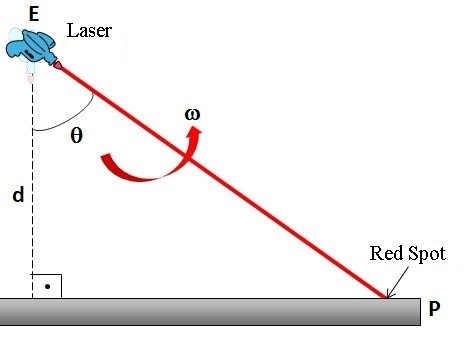Calculus on UCM
 A laser source, situated at a distance
from a plane wall
, rotates around an axis
, with constant angular velocity
, emitting a laser beam marks a red spot that moves in a straight line along the wall. The red spot has an instantaneous velocity
. The picture represents a view from above. Find
in terms of
,
and the angle
.
A laser source, situated at a distance
from a plane wall
, rotates around an axis
, with constant angular velocity
, emitting a laser beam marks a red spot that moves in a straight line along the wall. The red spot has an instantaneous velocity
. The picture represents a view from above. Find
in terms of
,
and the angle
.
This section requires Javascript.
You are seeing this because something didn't load right. We suggest you, (a) try
refreshing the page, (b) enabling javascript if it is disabled on your browser and,
finally, (c)
loading the
non-javascript version of this page
. We're sorry about the hassle.
Let D be the distance between the right angle and the Red Spot, is immediate that tan θ = d D → d tan θ = D , but D is the travelled space of the Red Spot, so by differenciating it we should be able to find the velocity. d t d ( d tan θ ) = d t d D = v applying the chain rule(*), d is constant. d d t d ( tan θ ) = d d θ d ( tan θ ) d t d θ . Differenciating it d d θ d ( tan θ ) d t d θ = cos 2 ω d = v .
(*): Here you could complain, "Why I have to use the chain rule and not just derivate just the tangent? " Well, as stated in the question the angle theta varies in the ratio of ω t , because is a uniform circular motion, so I can't just derivate the tangent, because I am doing that to respect to time and theta varies in time.